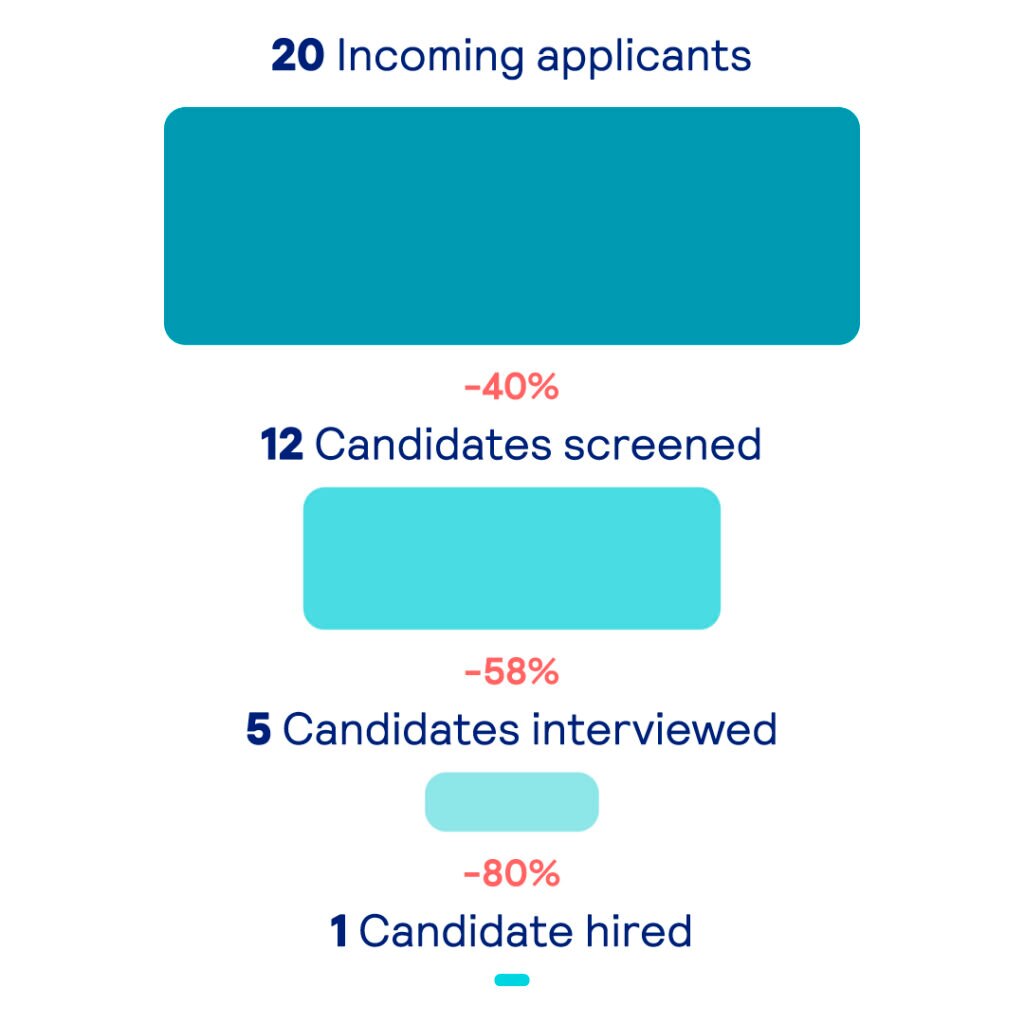In today’s competitive hiring landscape, recruiters face a consistent challenge: managing high volumes of job applications while securing the right candidate quickly. While it can be tempting to focus on driving up applicant numbers, a recent survey of 553 Irish recruiters makes one thing abundantly clear: quality always beats quantity when it comes to successful hires.
Volume vs. Value: The reality behind application numbers
Based on our recent research, the average number of incoming applications for most companies per role is 20. That figure varies slightly depending on the size of the organisation – 18 for SMEs and 37 for large enterprises – but the story remains the same:
-
Only 12 candidates progress to the screening stage.
-
5 candidates are invited to interview.
-
Typically, 1 candidate receives the job offer.

This narrowing funnel shows how selective recruiters must be from the outset. Simply attracting a high number of applicants doesn’t necessarily lead to better hires. A leaner, more qualified pool of candidates almost always leads to better results.
For recruiters, the insight reinforces the importance of clear job descriptions, targeted outreach, and strategic pre-screening to ensure time is spent on the most promising applicants.
Why candidates are rejected early
Understanding the most common reasons candidates fail early in the hiring process can help recruiters refine both their job postings and their initial evaluation criteria. Here’s what the survey found:
-
Lack of relevant skills (68%)
-
Lack of relevant work experience (55%)
-
Lacking necessary language skills (22%)
-
Unexplained employment gaps (22%)
-
Poorly formatted applications (21%)
For recruiters, these findings are especially significant. However, some roles may sometimes allow for broader learning curves, positions often require niche expertise or specific technical experience.
Thus, screening for skill relevance early, and communicating expectations clearly in job ads can significantly reduce wasted effort.
Why candidates fail at the interview stage
Even when candidates make it past screening, many still fall short during interviews. The top reasons include:
-
Poor communication skills (47%)
-
Concerns about reliability or commitment (36%)
-
Negative attitude or demeanour (33%)
-
Insufficient technical or role-specific skills (32%)
-
Unrealistic job expectations (29%)
This highlights a crucial point for recruiters: technical expertise must be matched with strong interpersonal skills. In client-facing, cross-functional, or leadership roles, poor communication can be a deal-breaker, regardless of technical proficiency.
Actionable tip: Introduce behavioural interviews and technical assessments early to ensure a more accurate measure of candidate fit before final rounds.
What recruiters should prioritise during screening and hiring
With so many applications to sort through, it’s vital for recruiters to zero in on what really matters. Our research highlights key priorities:
-
CV or resume (expected by 83% of recruiters)
-
References or recommendations (53%)
-
Cover letter (45%)
-
Completed job application form (44%)
Missing one of these critical documents can often be grounds for immediate rejection. Setting clear expectations in the job description about required documents can help streamline the process.
Top evaluation criteria
When assessing candidates, recruiters place the highest importance on:
-
Proof of right to work in Ireland (78%)
-
Clear and professional communication (74%)
-
Proficient language skills (71%)
-
Strong match between skills, qualifications, and work requirements (67%)
-
Complete set of application documents (65%)
In contrast, factors like having a professional photo (12%) and experience at top-tier employers (21%) were considered far less important.
What this tells us: Recruiters aren’t swayed by glossy CVs or an employment history littered with big names. They want practical, legally compliant, well-communicated, role-specific experience.
How recruiters can improve their hiring pipeline
With strategic improvements, recruiters can boost efficiency and quality simultaneously.
Before screening: build a strong foundation
-
Clarify role requirements: Go beyond vague titles – list key technical skills, certifications, or industry knowledge needed.
-
Set non-negotiables: If specific software skills, or certain certifications are essential, make that non-negotiable from the start.
-
Automate intelligently: Use applicant tracking systems (ATS) that can pre-screen based on keywords, but also set a human review stage to catch highly promising outliers.
During screening and interviews: focus on alignment
-
Implement structured interviews: Standardised questions ensure fair evaluations across all candidates.
-
Use scorecards: Rate candidates on critical competencies, rather than relying on vague “feelings” or personal bias.
-
Test real-world skills: Short technical assignments or case studies exercises relevant to the role can reveal more than a CV ever will.
After hiring: close the loop
-
Gather feedback: Ask candidates about the hiring process to identify any roadblocks or points of confusion.
-
Analyse success metrics: Track not just time-to-hire but retention rates, performance reviews, and cultural fit over the first 6-12 months to refine your strategy.
The pitfalls of prioritising quantity over quality
It’s tempting, especially in industries facing talent shortages, to open the floodgates and encourage as many applications as possible. However, this approach rarely leads to better outcomes. Here’s why:
-
Recruiter burnout: More applicants mean more time spent sifting through unsuitable candidates.
-
Increased risk of bad hires: Rushing to fill a role from a large, unfocused pool increases the likelihood of costly turnover.
-
Brand damage: A poor hiring experience for candidates can reflect badly on your company’s reputation in tight industries where word-of-mouth matters.
Instead, a sharper focus on role fit, preparation, and communication not only improves outcomes but also enhances your company’s employer brand in the long term.
A quality-first strategy wins every time
In recruitment, success doesn’t come from collecting hundreds of CVs, it comes from identifying, attracting, and securing the right candidate efficiently. Prioritising quality over quantity ensures that:
-
Recruiters spend time on candidates most likely to succeed.
-
Hiring managers see better candidates faster.
-
New hires deliver value more quickly and stay longer.
By refining job descriptions, enhancing screening processes, and focusing on meaningful criteria, recruiters can build stronger teams, faster and create a positive experience for candidates along the way.
Recruiter FAQs
Quality matters more than quantity in job applications because a leaner, well-qualified pool of candidates leads to better hiring outcomes. Focusing on attracting the right applicants reduces screening time and increases the likelihood of securing top talent efficiently.
What are the top reasons candidates are rejected early in the hiring process?
Candidates are often rejected early due to a lack of relevant skills or experience, poorly formatted applications, incomplete documents, missed instructions, or unexplained employment gaps. Clearly communicating role expectations can help reduce these issues.
What should recruiters prioritise during the screening process?
Recruiters should prioritise proof of right to work, strong communication skills, completion and quality of application documents, alignment of skills with the role, and necessary language proficiency. These factors help identify the most suitable candidates early on.
How can recruiters improve their hiring pipeline?
Recruiters can improve their hiring pipeline by clarifying role requirements, setting non-negotiable criteria, using applicant tracking systems for intelligent automation, and implementing structured interviews with competency-based scorecards. Post-hire feedback and success metrics analysis also enhance future hiring strategies.
What are the risks of focusing on quantity over quality in recruitment?
Focusing on quantity over quality can lead to recruiter burnout, increased risk of bad hires, and potential brand damage from a poor candidate experience. A quality-first approach helps maintain hiring standards and protects the employers reputation.
What is a quality-first hiring strategy?
A quality-first hiring strategy focuses on attracting, assessing, and hiring candidates who are best suited for the role. It prioritises targeted job descriptions, structured assessments, and meaningful evaluation criteria over simply increasing application numbers.
Download the complete How to improve the quality of job applications you receive guide for more insights and tools to help you hire smarter in 2025.
